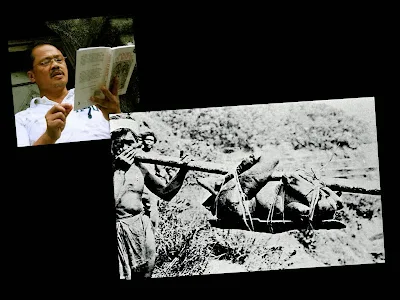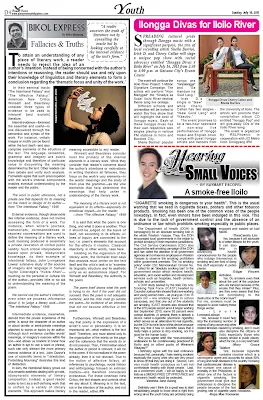If there’s one thing about Chinese poet Wang Wei (699–759) that makes him stand out among other poets of the T’ang Dynasty, it would be his unique combination of poetry with painting, and his integration of painting and poetry, summed by a later poet in the phrase: “poetry in painting; painting in poetry.”
“In his poetry there is painting and in his painting there is poetry.”
—Sung poet Su Shih.
The poet’s personal milieu brings forth poetry. Wang Wei had lived with or under manageable personal circumstances. Times during his day were relatively prosperous. Under such circumstances, along with the poet’s serene temperament, and his internalization of Buddhist’s religiosity and resignation, Wang Wei’s poetry thrived and articulated perfect calm and transparency.
Wang Wei’s works, 400 of them extant, are said to be affirmations of the Buddhist faith, an element which played a major part in the intellectual and spiritual life of T’ang Dynasty. Along with poets Lin-Tsung-yu’an and Po Chin, Wang Wei was considered serious student of Buddhist thought, significantly giving expressions to their religious views and ideals. Their works would even qualify to be the true Buddhist poetry, one which is distinguished from that which merely dabbles in Buddhist terminology.
Wang-chu’an Poems is a collective body of poems collaborated by Wang Wei and Pie Ti, whose sensibility reflects Wang Wei’s taste. The work was also drawn from the experiences of the two friend poets when they stayed in Wang’s self-earned estate in the south-eastern capital.
Containing 20 poems by Wang Wei and the companion poems of Pie Ti—it is a treasure trove of impressions, preferences and observations of Wang Chu’an, the estate whose name means “wheel stream,” after the place where it was built.
In a letter to friend P’ei Ti, Wang Wei shares some warmth which he must have found with P’ei’s companionship in the hills of Wang-chu’an. Very well he tells P’ei’ Ti that his companionship with him had been because he knew they would jive toward seeking quietude or perhaps enlightenment: "Perhaps you would then be free to roam the hills with me? If I did not know your pure and unworldly cast of mind, I should have not presumed to ask you to join in this idle and useless activity."
Wang Wei’s pieces also belong to the true Buddhist poetry in which the philosophical meaning lies much farther below the surface. Its imagery simultaneously functions on both descriptive and symbolic levels. Thus it is not at all possible to pinpoint the exact symbolic content of the image.
Representing a great advance over Tao Chien in the tradition of tien-yuan poetry, a precursor who had a large following at the time, Wang Wei turned the five-syllabic meter into a more supple tool of self-expression through parallelism, inversion, careful placing of pivotal words and variations in the placing of the caesura in each line.
Yin & Yang. Considered one of the greatest High T’ang poets, Wang Wei’s works often take a Buddhist perspective, combining an attention to the beauties of nature with an awareness of sensory illusion. His work is an interface of reality and fantasy or imagination, traceable to the twin influences of Buddhism and landscape painting. Wang Wei’s poems are distinguished by visual immediacy on one hand and by meditative insight on the other.
Wang Wei’s poetry appeals to the reader because the poet is able to explore the world of nature and men; the poet virtually communicates directly with the reader; and the poet gets to express what is seldom expressible in any language—the profound insight of a poet to “see into the life of things.”
Wang Wei’s inspiration for landscape. An earlier poet named Hsieh Ling-yun (385–433) who lived 400 years before Wang Wei’s time must have provided the inspiration for the Wang-chu’an poems, as is obvious from the names of his hills and mounds—Hua-tsu-kang Ridge, Axe-leafed Bamboo Peak—places celebrated by Hsieh Ling-yun himself.
This poet has keen eye for detail, whether describing the simple rustic life on a farm or writing about the joy and peace he found in nature. His poems blend the most concrete vocabulary with the abstract, empty, being, non-being, etc. Such effort he takes to create a special atmosphere—
The birds fly south in unending procession
These hills again wear the colours of autumn
Their green leaves fluttering over an eddying stream
Pliant yet upright, these bamboos adorn slope and peak.
Depicting the real scenes or panoramas where he consciously chosen for introspection, Wang Wei’s Wang chi’an poems attempt to sketch these places—the way details of colour, light, sounds and scent are carelessly interspersed—thereby virtually creating impressive panoramas and perspective.
What makes Wang Wei’s poems most interesting is that the poet is able to explore, or play around the world of nature and man; he is also able to get his message across the reader; and he is able to articulate the grandness of a poet’s insight—“to see into the life of things,” one which is hardly expressible in any language.
Deep in the bamboo grove I sit alone
Singing to the brimming music of the lute
In the heart of the forest I am quite unknown
Save to the visiting moon, and she is mute.
~“Bamboo Villa”
.jpg)

.jpg)





